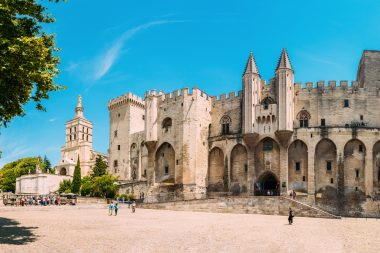The southern French city of Avignon is located in the heart of Provence. It is not only called the river city because of its geographical location, but also the city of the popes because of its religious past. From 1309 to 1417, Avignon was the seat of the pope and the capital of Christianity. The historic city centre with its impressive stone architecture is under the protection of UNESCO and was declared a World Heritage Site in 1995. The Papal Palace, the 12th-century cathedral and the Hotel d’Europe are examples of well-preserved buildings from the time of the medieval papacy. The medieval bridge Pont d’Avignon is particularly world-famous, which is sung about in a well-known French folk song that the whole world can probably sing along.
Location of the city
The southern French city of Avignon is located in the heart of Provence. It is the largest city and administrative center of the department of Vaucluse. Here the two rivers Durance and Rhone join together, with the Durance forming the southern city boundary, the Rhône separating the city from the department of Grad. As early as the Neolithic Age, the first settlements existed on the Übel Rocher des Doms. During Roman times, Avignon was an important trading center, and in the 14th century, popes ruled over Avignon
Best time to visit
Avignon has a Mediterranean climate, similar to that of Nice or Marseille. This means that the maximum daily temperature in the months of April to October is between 20 and 26° C. From November onwards, the weather cools down quickly, but the winters are so mild that you can still wear comfortable clothes without any problems. Apart from violent thunderstorms in summer, the region around Avignon is rather low in precipitation.
Avignon’s top sights
The historic city centre is home to numerous sights, which are particularly reminiscent of the time as the papal seat. Friends of fascinating medieval architecture in particular will get their money’s worth in Avignon. These are the must-see highlights for every visitor.
Saint-Benezet Bridge
The famous “Pont d’Avignon”, built in the 12th century, is the symbol of the city. It was once more than 900 m long and connected the two districts on the left and right of the Rhone. The bridge was repeatedly destroyed by floods and wars and had to be restored. Today, only four of a total of 22 arches have been preserved.
The Saint-Benezet Bridge was named after Saint Benezet, who is said to be responsible for the construction of the bridge. According to legend, the shepherd boy Benezet was instructed by an angel to build a bridge. He proved his divine power by carrying the foundation stone. According to a world-famous French folk song, people dance happily on the Pont d’Avignon. Those who visit the remains of the Saint-Benezet Bridge will have a fascinating view of the city walls and the Palace of the Popes.
Palace of the Popes

The Pope’s Palace is one of the absolute highlights of the city. A visit should definitely be on the to-do list of tourists. The palace, built in the 14th century, was the residence of several popes and represented the power of the Catholic Church at that time, which can be seen from the fact that this gigantic building in Gothic style has little to do with a normal papal residence. It is more reminiscent of a castle as you know it from secular rulers. Almost all areas of the palace can be visited, including the two-storey cloister, the courtyard of honour as well as the private apartments of the popes and the dining and banqueting hall. A touchscreen tablet provides insights into the facilities and uses of the rooms at the time.
Avignon Cathedral
The Romanesque-style Avignon Cathedral stands right next to the Palace of the Popes and dates back to the 12th century. A special highlight is the gilded statue of Mary on the top of the bell tower. Also worth seeing are the baroque interior and the bishop’s throne made of white marble, on which the popes sat. In addition, the mausoleum of Pope John XII and the treasury can be visited.
Place de l’Horloge
A few steps away from the Palace of the Popes is the Place de l’Horloge, where modern life pulsates. Numerous bars and restaurants invite you to linger and celebrate. For kids, the nostalgic carousel in the middle of the square should be a highlight. Particularly interesting are the town hall, the opera house and the clock tower, which gave the square its name. From here you can also reach the pedestrian zone, where many shops and boutiques offer opportunities for strolling and shopping.
Les Halles
Gourmets will get their money’s worth in the market hall. A special eye-catcher is the northern façade, which consists of a vertical green garden. The market hall opens every morning from Tuesday to Sunday.
Les Grads Bateaux de Provence
The one-hour boat trip on the Rhône offers a beautiful view of Avignon. A reservation is not necessary.
Rocher des Doms
On this rocky outcrop in the north are the Pope’s Palace and the great Hathedrale. In the Neolithic Age, the first inhabitants settled here, which is why the Rocher des Domes is considered the cradle of Avignon. Behind the cathedral is a park that is used by many families for local recreation. There is a plateau, a lake, lawns and old trees that provide shade Children can let off steam on two playgrounds. There is also a restaurant with a snack bar. Dogs are not welcome in the Jardin des Roms.
Festival d’Avignon
The Festival d’Avignon takes place every year in July. The art festival attracts numerous visitors to the city with theatre, film and dance performances as well as street theatre and walking acts.


